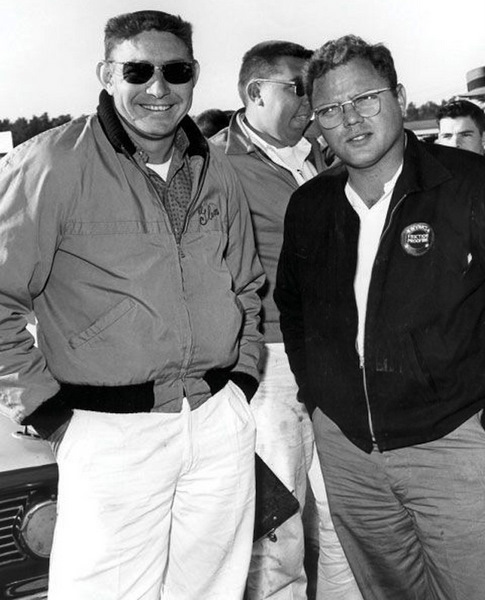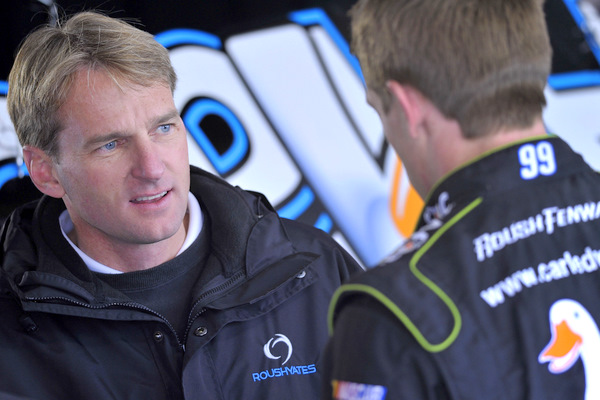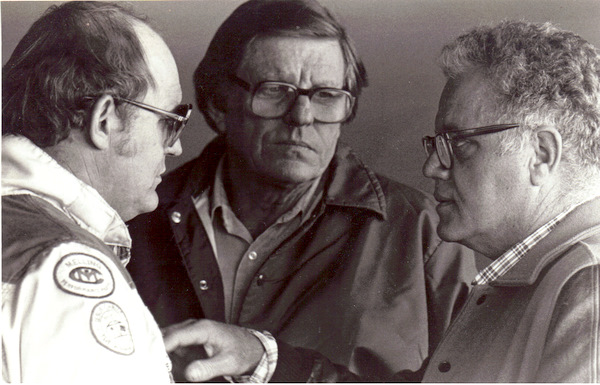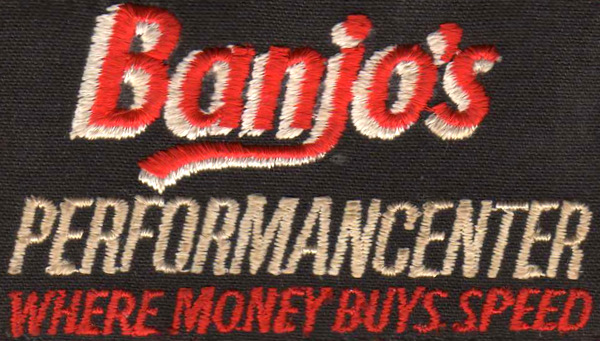Somthing lost...something gained: the way we were, the way we are

NASCAR legends Fireball Roberts (L) and Banjo Matthews, circa 1963 Daytona (Photo: Daytona International Speedway)
By Mike Mulhern
mikemulhern.net
Alas, Matthews passed away 15 years ago, far too young, and the sport lost a great sage, and very good teacher, one of the true geniuses in NASCAR history, who could put whatever issue at hand into perspective, without political spin.
Now Fox' sports boss David Hill brought his cameras into this sport with the philosophy "No dead guy talk," believing (however misguided) that NASCAR fans really didn't care to hear about a sport's legends, once proclaiming "If anybody talks about a dead guy during a broadcast, I'll sack them."
Odd, yes.
So you probably won't hear anything about Banjo Matthews on Fox TV. Too bad Matthews himself isn't around to school Hill about this sport.
After all this is as much a sport of legends as it is of rubbin' and feuds and fighting.
For years Matthews' parts hauler, emblazoned with that famous logo 'Where money buys speed,' was a fixture on the stock car circuit every weekend.
That was back in the day before these stock car teams became monolithic corporations, back when small teams roamed the NASCAR trail, and the Friday or Saturday race week need for a part or two could be crucial…and where a timely tip or two could make a big difference.
And now most crew chiefs simply hole up in their own rig, in front of half a dozen computer screens, in the days leading up to the race….
Butch Stevens and Dick Hutcherson, famous in their own right, were for a time rivals of Matthews, and then carried on Matthews' legacy.
And their long-distance racing parts haulers were like country stores for this sport, the kind of place men would hang around at and chew the fat, discussing the affairs of the day, as well as dealing parts.
The only thing missing was a potbelly stove. (But they could get you one by Sunday, for a price…)

Engine whiz Doug Yates (L) and Carl Edwards, the Sprint Cup tour points leader (Photo: Autostock)
However times change, inventories became increasing complex and expensive to maintain, particularly with parts and pieces coming in from around the world, and sometimes with a shelf life in this sport way too brief for profitability.
Stevens' BSR hauler and Hutcherson's Hutcherson-Pagan Enterprises hauler were just four years ago still thriving operations. But both companies saw the writing on the wall and sold out, and their haulers are no more seen in NASCAR garages around the circuit. (Hutcherson himself died in 2005.)
But then the companies they sold to also discovered the short shelf life of stuff in this sports-business, and the high cost of inventory. And how long they might want to hang in this game is unclear.
The always tricky and expensive business of high-performance racing parts has just, well, changed. NASCAR teams do much of the work in-house now, or get parts shipped in straight from Detroit car makers, who are all but squeezing independent parts suppliers out of the game. Tricky widgets that used to be created in secret backroom shops around North Carolina now come in from around the world…and of course at a price. Yes, Formula 1 parts suppliers have found NASCAR…
But this is all at a loss, however quaint it might seem in today's fast-paced racing world.

Banjo Matthews (R), with car owner Bud Moore (C) and Benny Parsons, circa 1981 (Photo: Daytona International Speedway)
Hey, let's chew the fat here for a moment:
-- NASCAR and Detroit are slowly working toward a new Cup car design for 2013. Heck, it needs to be coming out in 2012, if they want this sport to recapture some relevance. Stop dragging feet. Give me another can of Skoal, bro….
-- Let's cut costs. Eliminate expensive carbon fiber parts where they're not really needed. Eliminate expensive tungsten as ballast. Ban expensive titanium parts. Some teams have found so many lightweight but very expensive weight-cutting angles that their cars are carrying more than 400 pounds of ballast. If free-weight allowed in these cars was limited to, say, 150 pounds….Hey, got a Winston….
-- Let's take a look at why the life-cycle of one of these top Sprint Cup cars is only about 90 days…before it becomes relatively obsolete. Wasn't this common template 'uni-car' supposed to be cheaper and help open the sport up to new team owners? What has happened to that part of the game plan? Why is this sport increasingly just a 'closed-shop,' dominated by a handful of team owners who have become increasingly dependent on car makers' support? (And woe be to any independent team owners who can't line up a good Detroit connection.)
-- Let's cut more costs. No lithium batteries. Reliability, you say. Hey, why do these cars have to be so bullet proof anyway. Cut down on reliability and open up the Sunday games to a little more variety.
-- Cut more costs: drop this fuel injection thing. No fan is going to be opening any of these hoods to see if it's got a carburetor or not. And, hey, why can't NASCAR give teams an answer when asked what's the price for these new fuel injection systems….which will apparently have to be handled through some type of NASCAR parts operation.
-- Let's really cut costs: limit owners to just two Cup teams. When teams began expanding to three and four teams, that's when the sport became so unbalanced.
Ah, but we digress.
For Robert Yates, customer engines were always a major business. Now the son of the famous NASCAR engine builder is taking that to a whole new level (Photo: Getty Images for NASCAR)
Yes, times change, and now here comes a new, high-tech NASCAR parts operation, vying for a share of the racing market, run by Doug Yates and Jack Roush.
A more sophisticated parts operation, each piece coming with a 'car fax' history of authenticity – where it was run, and how many hours.
Chief salesman: Jeff Clark, the former engine builder for Dale Earnhardt Jr. during those days of DEI glory, now selling rather than building. "It helps to know your product, and my background in building and tuning definitely gives me some resources," Clark says.
Clark, a 20-year NASCAR veteran, got his start with legendary Robert Yates (Doug's father), spent time building engines for Roger Penske, and then moved over to Dale Earnhardt Inc., to work with Earnhardt.
Now Clark is a point man for a very aggressive new Roush-Yates business venture, now about two years in the running.
Yes, the Yates name is big in NASCAR engines. And Roush is always looking for new business angles to work.
Used to be that top NASCAR teams could sell off their old stuff at the end of the season to ARCA or other racers. But that hand-me-down scenario hasn't worked for years.
And with the ever-shorter life cycle of top NASCAR equipment, well, finding new markets for that stuff has been a priority.
This part of the expanding Roush-Yates racing operation started out two years ago primarily as a way to broker used parts, engines and such.
Now it's expanding, developing new racing engines for series that rarely even saw Fords.
Roush, like most top NASCAR team owners, has a strict timeline life cycle for each part, and when he judges it's reached that limit, he sells it. Not that the part is worn out, of course, but that his 'reliability index' has been reached. And Clark says meticulous records are kept for each such part offered.
"It started out primarily for the Roush teams, but the way we structured it and organized it, other teams saw and liked the way we do our parts management, and they've come on board too," Clark says.
Now the Roush-Yates division does business with Dale Earnhardt Jr.'s JR Motorsports, Tony Stewart's Stewart-Haas Racing, and Roger Penske's Penske South.
"Non-Roush teams…that may be a surprise to people on the outside…but this gives them a better return on their parts, as far as dollar received," Clark says.
"And if there is a part that needs to be destroyed, we make sure it gets destroyed, and doesn't get recycled as a souvenir at somebody's house on on e-Bay.
"So we really, really manage the part from start to finish.
"And we also carry new parts. This led to the birth of a new parts division; knowing there is a lot of mark-up in that, we've backed off that, and offer new products for sale to the other teams as well.
"We're taking the same product lines that other parts suppliers carry and offer them at not such a healthy markup."
When Hutch-Pagan and Butch Steven sold to capital management groups a few years back, those new operations tried to get lean-and-mean.
"One big thing about the racing parts business," Clark says, "is you've got to have the parts on the shelf. All the parts.
"They didn't like that. Because that's a lot of overhead, inventory.
"They started leaning out the inventory and losing sales.
"We're coming in with full-stock."
And, Clark says, "We're very aggressive."
It's also expanding. "We've gone from six employees to 22 over the past year and a half. And our product lines went from maybe 60 to over 400.
"The investments we started making two years ago are just now starting to show returns. And we're still growing a lot of markets. We have markets as far away as Australia – we won the Gold Cup two weeks ago, and we won it with a Ford, which is unheard of.
"And we are all brands."
Even Toyota products? "Yes, Toyota parts too," Clark says.
"But the performance engine group (parts) are for markets outside of NASCAR – sprint cars (with 360s and 410s), off-road trucks. We haven't gone into that market here, because Toyota is well represented by TRD and Triad. But all the other American brands, we're very successful with that."
The life cycle of NASCAR parts has become notorious short for Cup teams. That, Clark says, makes for a good used parts business: "The mindset of the racer is always improve and get better. But that creates obsolete parts.
"And we (on the Cup side) can't have a part that fails. So we 'mileage' out our parts.
"Things as simple as ignition boxes, we probably mileage out sooner than they need to be, but we do that for fear of a failure.
"That creates used parts….but they're good parts.
"We bench-test the new parts going into the car, then we cycle them out and can offer them to Saturday night racers Anywhere USA.
"We inventory everything for mileage. We will not stock a part that has been in a crash or an engine failure; those go to shred, and we get recycling credits – we're trying to be green here. And we get certification that the part has been destroyed, so it doesn't end up as a souvenir somewhere.
"We sell and broker cars for every brand. We sell Fords, Chevrolets and Toyotas through the parts store. We broker all engines.
"Teams like the way we handle things; we typically get them a better return. And we also help the customer – because when we're racing, we're racing, and not focused on customer service.
"But our company is focused on customer service, and we answer all the questions and give the customer all the data, a carfax so to speak – a certificate of the history of where the part has competed, and the mileage. That's the customer service that's deserved, because a race car is a pretty expensive piece."
And seemingly not getting any cheaper.
But then money does buy speed. Just ask Banjo.

© 2010-2011 www.mikemulhern.net All rights reserved.
Web site by www.webdesigncarolinas.com







Before the manufacturers help
Before the manufacturers help design a new Cup car, they need to be taken to task for not working to make the parts the racers use be able to last for multiple races. These cars are fast but they need new parts every week. That makes no sense.
Also, just why did Cup need a new car design to begin with? The old long lean look worked - if they want more drag then bolt on a roof blade.
The myopia of the manufacturers needs to be ended.
Post new comment